The Chapel's stained glass windows
The stained glass windows are the work of Marie-Josèphe GUEVEL, who won the 1989 International Stained Glass Prize in Chartres.
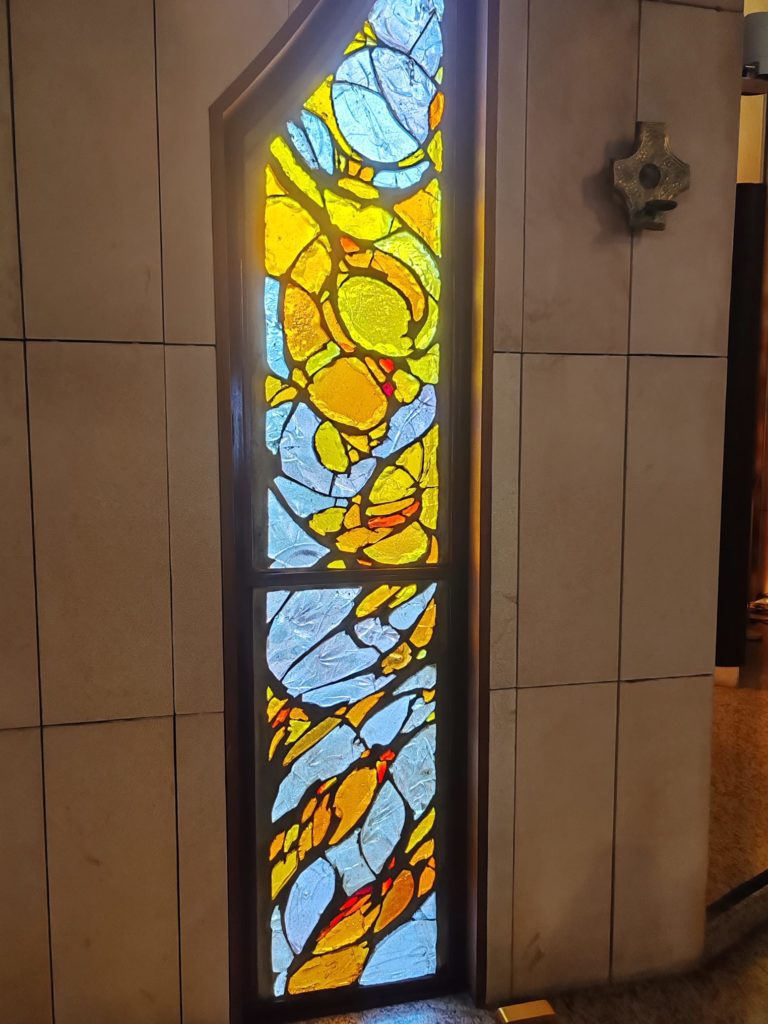
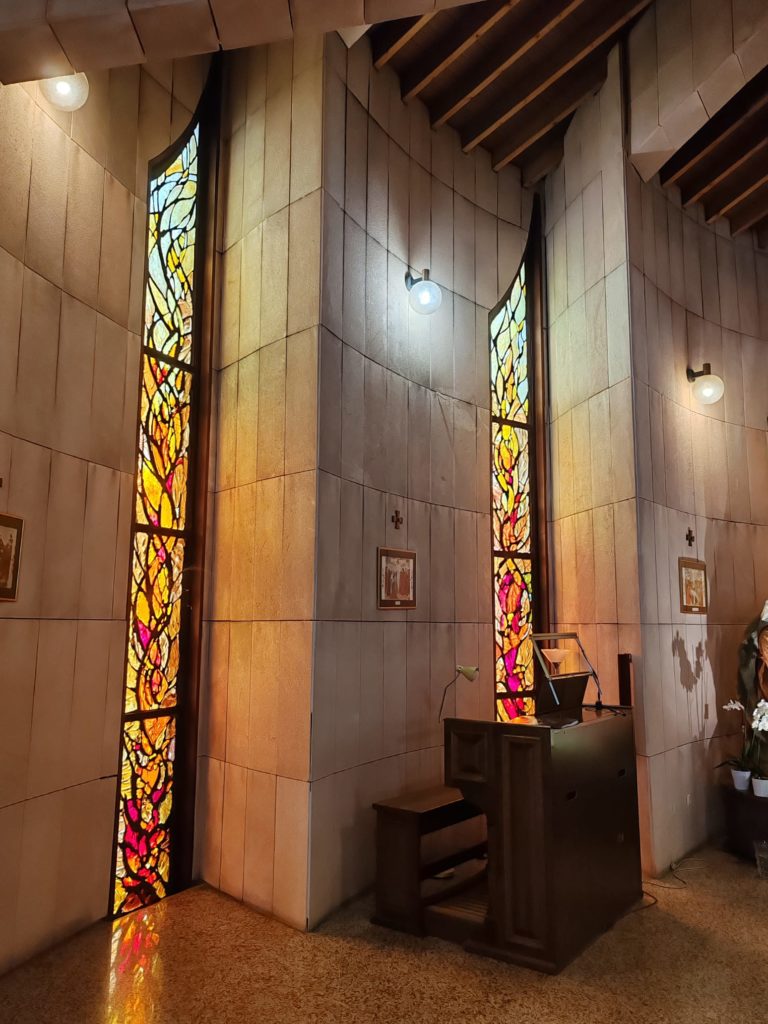
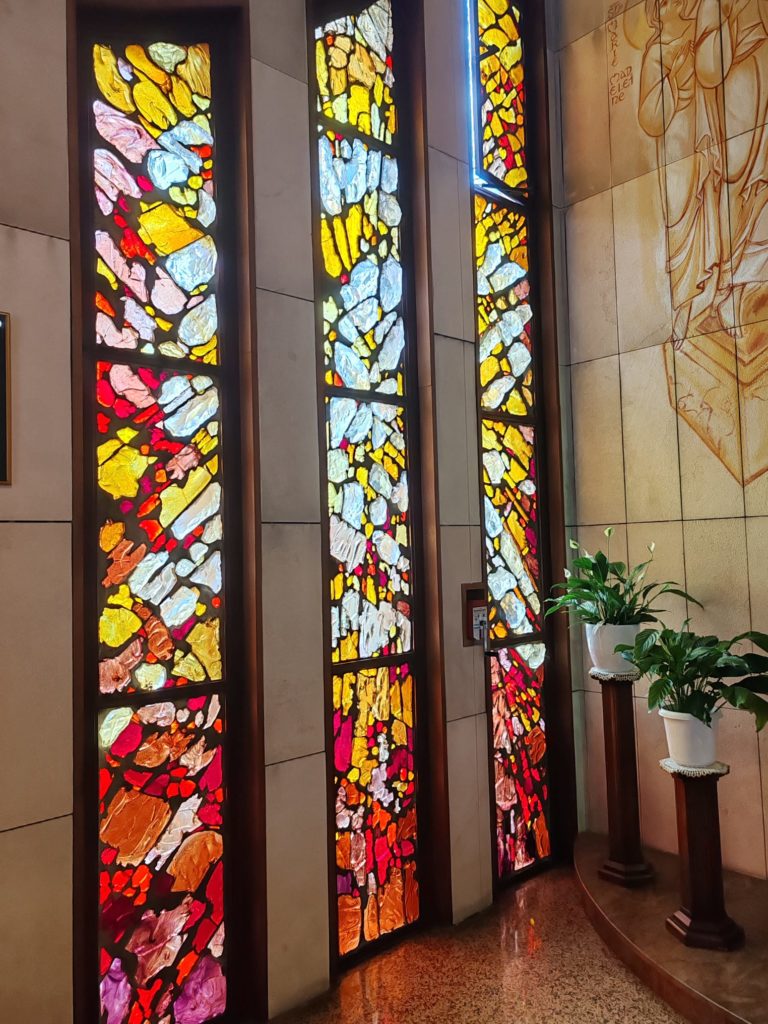
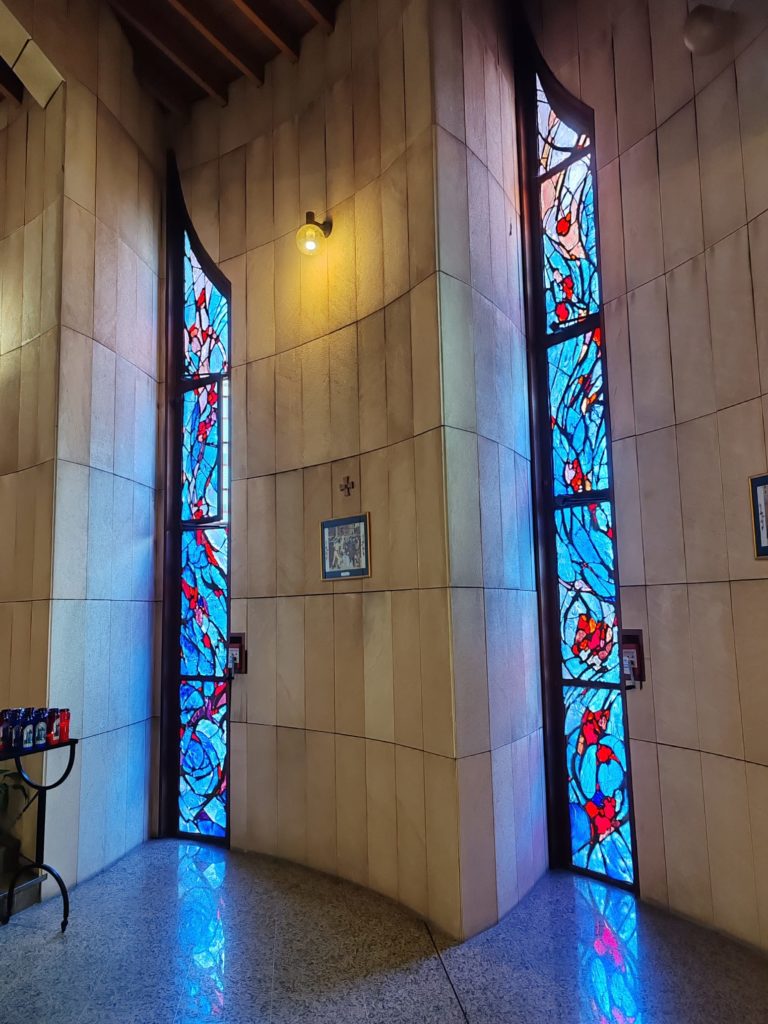
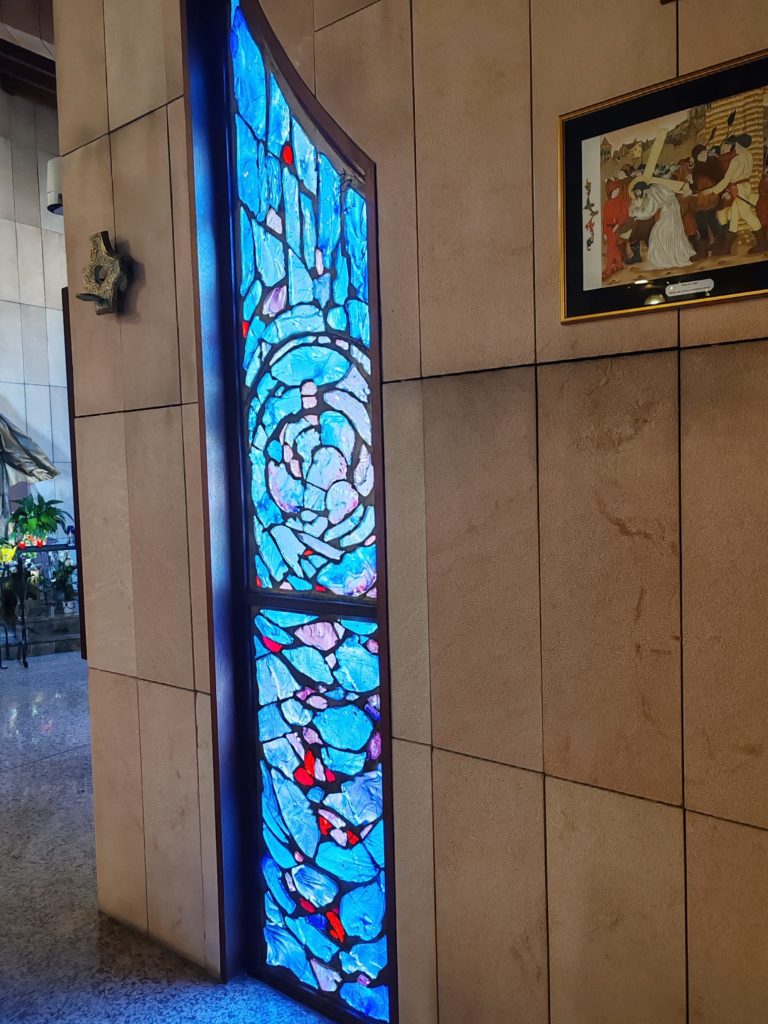
- The section on the left, facing the altar, is dedicated to Jesus Christ, Master and Lord, the "Anointed One" who brings salvation, represented by the dominant red and gold, according to an ancient tradition.
- The 1st stained-glass window on the left tells us about the announcement made to Mary, the moment of the biblical story of the Annunciation [see 1st photo from left]. This window represents the fertilization of our material world by the Spirit of God. A composition that is both biological and cosmic in form... at once embryonic and galactic in its dynamic spiral form. Yellow symbolizes the Holy Spirit, gray, matter.
- The next three stained glass windows,again on the left, have Pentecost as their theme [see 2nd photo from left]. These windows represent the light of the Holy Spirit promised by Jesus Christ to his apostles and, by extension, to us all. The flames are not just arrows placed on their heads, symbolized by the twisted design, but also our inner illumination by the Holy Spirit.
These stained glass windows must therefore give the impression of a diffuse, penetrating radiance: the Holy Spirit must be inside us, not outside us. The upper part of the windows, luminous and golden, symbolizes God, the divine light, while the lower, darker part represents man.
The design also recalls wheat, the harvest, God’s own harvest. Pentecost was celebrated by the Jews at harvest time.
- The three large stained glass windows in the choir on the left, near the tabernacle [see center photo ], have the Resurrection as their theme . Key windows, since the Church is the Church of the Risen Christ.
These stained-glass windows had to shine with the light of Jesus Christ, who illuminates us all. We see the cross , but above all the dazzling spiritual light of the risen Christ, given by crystal blocks cut into the mass, pushing to the sides the elements of matter: rocks, pebbles, dead flesh and all that is lifeless in us. The darker part at the bottom shows that the history of the world changed after Christ’s coming and resurrection, with light opposing shadow.
- Looking at the altar from the right,we see the 3 stained-glass windows of Saint Rita and the Virgin Birth (the smallest window: 1st on the right).
- Generally speaking, the right-hand side of the chapel is dedicated to the Virgin Mary and Saint Rita: the dominant color is blue.
Blue and mauve scrolls, like a protective mantle, envelop and irradiate the statue of Saint Rita with the tender lights of kindness and compassion. The red spots symbolize the saint’s sufferings: the blood on her forehead, as it rises to God, is transformed into roses, that is, into graces for us. These roses also symbolize the Virgin Mary, and in the 4th window, behind the statue of Saint Rita, they are transformed into “Rosa mystica”, the perfect flower, symbolizing Mary. In contrast to the strong colors of the lower part of the windows, the upper part lights up in the colors of Christ, in indentations, a symbol of hope for those who, in despair, pray to Saint Rita.
These windows are particularly designed to inspire prayer and meditation. They are gateways to the spiritual world, to be entered slowly. Like music, it’s the right tuning of the tones, the exact placement of the harmonic line, that moves the viewer beyond anything that first-level symbolism can convey. The same applies to all the chapel’s stained-glass windows.
- Another stained glass window is very interesting. It is located in the choir, to the left of the crucifix and the altar. It illuminates the altar with its warm, reassuring light. It is conceived as a symphony rising from earth to heaven.
- The rhythm of the design draws the eye from the earthly bottom to the celestial top, which illuminates the altar , recalling Christ's words as recounted by St. Matthew: "I am with you always, to the end of the age".
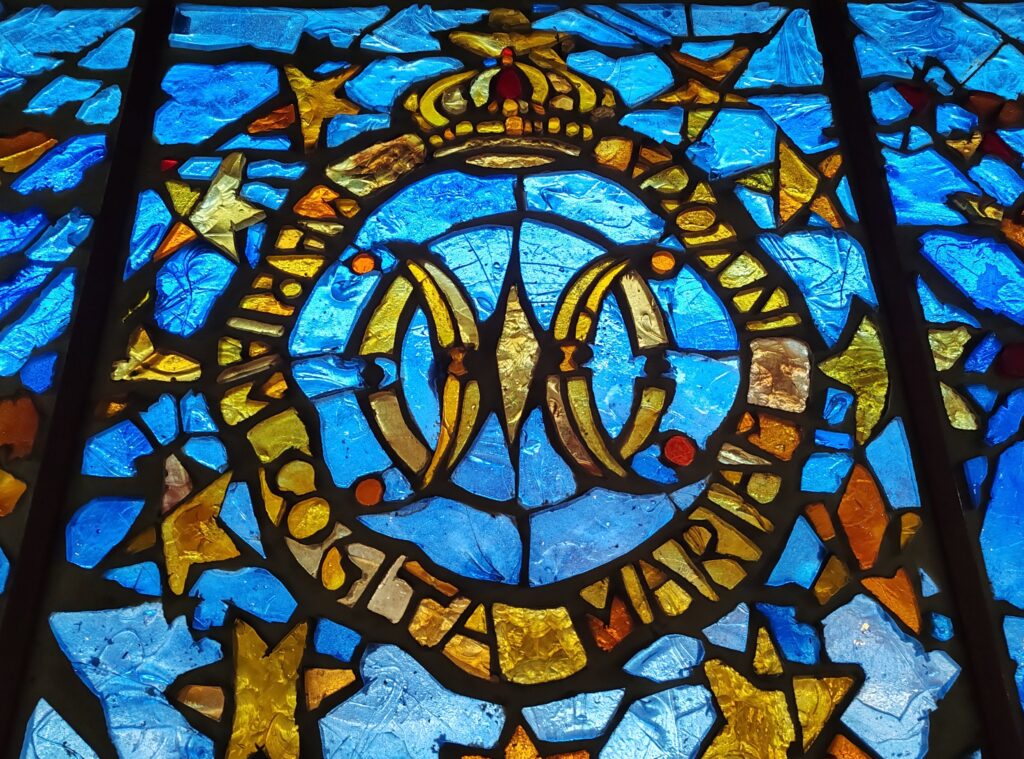
- At the back of the chapel, in the porch, the coat of arms of the Oblates of the Virgin Maryin gold and yellow, the colors of Christ, stand out against a starry blue background, the symbol of the Virgin Mary.
The Oblate coat of arms dates back to around 1840. The Marian initials include a M (Marie), the upper part of which flares into a V (Virgin), surrounded by an O (Oblates). In the center, the small point upwards corresponds to the symmetrical point downwards; we can also read an A, the second letter of Mary: for it was customary in antiquity to make abbreviations with the first two letters of the name (see, for example, the “khi-rho”, XP, for Christ). In fact, it’s very common in Christian art to see an intertwined A and M, which are also the initials of the Ave Maria (“Hail Mary in Latin). In Latin, O.M.V. stands for “Oblates of the Virgin Mary”. The motto ” Mariam cogita, Mariam invoca “. Pense à Marie, invoque Marie ” comes from Saint Bernard (Sup. Missus est 2,17). The crown of twelve stars comes from the Apocalypse: “Then a great sign appeared in Heaven: a woman clothed with the sun, with the moon under her feet, and on her head a crown of twelve stars” (Apoc. 12:1). This crown has been attributed to the Virgin Mary since time immemorial, and appears on the medal that Mary herself asked Saint Catherine Labouré for in 1830, during the apparitions in the Rue du Bac in Paris.
- The top of the porch doors represents the glory of God extending to the cosmos, to the entire universe.
Support your sanctuary
Your support helps us to continue the various activities of this place of sanctuary.
Contribution to the Mass
Ask the Sanctuary of Saint Rita for a mass for your intentions, commemorating the Eucharist and the presence of Christ.
Lighting a candle
Candles burn ceaselessly, symbolizing our prayers and thanksgiving for our lives to become light.
Prayer intention
Saint Rita, patron saint of lost causes, welcomes your intentions and thanks, and may fraternal charity strengthen our prayer.
